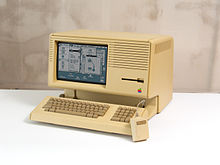Macintosh XL
 | |
| Release date | January 1, 1985 |
|---|---|
| Introductory price | US$3,995 (equivalent to $11,318 in 2023) |
| Discontinued | April 29, 1985[1] |
| Operating system | MacWorks XL/System 1.1,[2] 2.0, 2.1, 3.0, 3.2; MacWorks Plus/System 1.1–6.0.3; MacWorks Plus II/System 1.1–6.0.8, 7.0–7.5.5 |
| CPU | Motorola 68000 @ 5 MHz |
| Memory | 512 KB RAM (Lisa DRAM card), expandable to 2 MB |
| Predecessor | Apple Lisa Macintosh 512K |
| Successor | Macintosh Plus |
The Macintosh XL is a modified version of the Apple Lisa personal computer made by Apple Computer, Inc. In the Macintosh XL configuration, the computer shipped with MacWorks XL, a Lisa program that allowed 64 K Macintosh ROM emulation. An identical machine was previously sold as the Lisa 2/10 with the Lisa OS only.
Hardware
The Macintosh XL had a 400K 3.5" floppy drive and an internal 10 MB proprietary Widget hard drive[3] with provision for an optional 5 or 10 MB external ProFile hard drive with the addition of a parallel interface card. The machine used a Motorola 68000 CPU, clocked at 5 MHz together with 512KB RAM. At the time of release in January 1985, the Macintosh XL was colloquially referred to as the "Hackintosh",[4] although this name has since been used more generally to describe Macintosh computers assembled from unusual combinations of parts or, after Apple's transition to Intel processors, to denote PCs running OSx86, a hacked version of Mac OS X. The Macintosh XL was discontinued in April 1985.[1]
Upgrades
Because of its roots as a Lisa — unlike all other Macintosh computers — the stock Macintosh XL used rectangular pixels.[5] The resolution of the Macintosh XL's 12 inch (30.5 cm) display was 720x364. Square pixels were available via the Macintosh XL Screen Kit upgrade that changed the resolution to 608x432.[5] The CPU could be replaced with a new CPU board containing up to 8 MB RAM, called the XLerator 18.[6] The maximum upgraded RAM with conventional add-in RAM cards was up to 2 MB[7] - four times larger than the maximum capacity of earlier Macintosh computers. (With modifications to the CPU board, the Macintosh XL could accommodate up to 4 MB of RAM.[7])
MacWorks
MacWorks Plus was developed by Sun Remarketing as a successor to MacWorks XL in order to provide application compatibility with the Macintosh Plus computer. MacWorks Plus added support for an 800 KB 3.5-inch floppy disk and System software up through version 6.0.3. MacWorks Plus II extended that to the same 7.5.5 limit imposed on all 68000 processors.[8]
History
The re-badging of the XL was a last-ditch effort by Apple to save the poorly selling Lisa which had been usurped by the Macintosh line. After two years of marginal sales Apple was unprepared for the record number of orders placed for the newest member of the Macintosh family.[9]
Discontinued
Despite its relative success, the Macintosh XL was discontinued because it was literally unavailable. Parts had not been ordered to keep the XL in production and once the last of the parts ran out, Apple made the decision to shut down production for good.[10] In 1986, Apple offered all Lisa/XL owners the opportunity to turn in their computer along with US$1,498.00, and receive in exchange a Macintosh Plus and Hard Disk 20 (list price US$4,098.00 at the time).[11]
Sun Remarketing
After Apple dropped the XL from their price list in September 1985, Sun Remarketing of Logan, Utah bought a number of Apple's remaining inventory and continued to sell them under license with their updated version of MacWorks Plus, re-branded as the Macintosh Professional.
Though no new Lisas were available for sale, development continued on MacWorks Plus to support the installed base of Lisas, making them as relevant as their closely related cousin, the Macintosh Plus.
Legacy
The Macintosh XL shares the same legacy as the Lisa before it. However, the increased sales from the emulation of the Macintosh operating system proved that the Macintosh family badly needed a more professional environment which could provide larger monitors, greater memory and more expandability than the Macintosh 512K offered.
| Timeline of Compact Macintosh models |
|---|
 |
Timeline of Lisa models

See also
References
- ^ a b Linzmayer, Owen W. (2004). Apple Confidential 2.0: The Definitive History of the World's Most Colorful Company. No Starch Press (retrieved via Google Books). p. 80. Retrieved January 2, 2014.
- ^ "System Software: Configs for Mac 128K, XL, 512, & 512KE (7/94)". Apple Computer, Inc. February 18, 2012. Archived from the original on August 20, 2012.
- ^ Linzmayer, Owen W. (2004). Apple Confidential 2.0: The Definitive History of the World's Most Colorful Company. No Starch Press (retrieved via Google Books). p. 79. Retrieved January 2, 2014.
- ^ Raymond, Eric S. (December 29, 2003). "Hackintosh". Retrieved January 2, 2014.
- ^ a b Pina, Larry (1991). Macintosh Repair & Upgrade Secrets. Hayden Books. p. 274. ISBN 0672484528.
- ^ XLerator 18 "XLerator"
- ^ a b Pina, Larry (1991). Macintosh Repair & Upgrade Secrets. Hayden Books. p. 273. ISBN 0672484528.
- ^ MacWorks Plus II
- ^ "Apple's Lisa Meets a Bad End". InfoWorld. 7 (22). InfoWorld Media Group, Inc. (retrieved via Google Books): 21. June 3, 1985. ISSN 0199-6649. Retrieved January 2, 2014.
- ^ Book Review: AppleDesign and Apple: The Inside Story
- ^ "Semaphore Signal 26". Semaphore Corporation. March 1986. Retrieved January 2, 2014.
